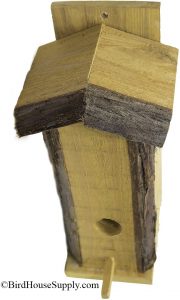The materials used to construct the bird nesting box will make a big difference in what type of birds are attracted to it. Birdhouse materials vary greatly by manufacturer, so it is important to check the product’s description out thoroughly before purchasing. How to choose a birdhouse for your yard will depend largely on what types of birds you want to attract, where you live and the natural landscape around your home.
Different materials for different birds
 Most birds prefer to make their nests in houses made of natural and untreated wood materials. The nesting box may have painted, stained or metal details, but the interior of the house should be untreated. Look for birdhouses made of red cedar or bald-cypress ideally. Pine and plywood will work as well, but expect to replace it more often.
Most birds prefer to make their nests in houses made of natural and untreated wood materials. The nesting box may have painted, stained or metal details, but the interior of the house should be untreated. Look for birdhouses made of red cedar or bald-cypress ideally. Pine and plywood will work as well, but expect to replace it more often.
Plastic, acrylics and varnished or treated wood make poor houses for most birds, because they attract and store heat. The one exception in synthetic housing is concrete. Although concrete birdhouses are often expensive and difficult to erect (can we say heavy?) they provide a safe-haven from predators that other, less-industrial, materials cannot. Keep in mind, if you decide on concrete, ventilation is still tremendously important. Purple Martins, Woodpeckers and Wood Ducks are not likely to make their nests in a concrete house, but most others will consider it in places where weathered wood seems unavailable.
Purple Martins love to nest in gourds or gourd-like houses, but this type of birdhouse often needs to be replaced on an annual basis. For any other type of bird it is best to stick with natural woods like the one pictured here.
The Color of Home
If you choose a birdhouse that is painted on the exterior, make sure it is the right color for the birds you’re trying to attract. Much of coloring is dependent on how it reflects the light and/or blends with the environment, not so much on the color itself.
Purple Martins prefer white houses. Most other birds will take better to the natural tans, dark greens and grays found in nature. In addition to being attractive to the birds, these colors reflect heat and make the nesting box less conspicuous to predators.
Whichever color you choose, do not buy a bird nesting box with the interior or entrance hole painted. The fumes from the paint could harm the tiny lungs of the adult birds and their offspring.
Drainage and Ventilation for your birdhouse
Make sure the birdhouse you choose has drainage in the bottom of the box, to allow moisture to find its way out easily. Drainage holes should be small, just enough to release moisture. Many Woodlink birdhouses leave space for drainage on the edges where the boards connect which also works well.
Check for ventilation in other areas as well, ideally high on the sides and under the roof easement, to allow your nesting box adequate airflow without letting in large amounts of rain, wind or snow.
Weathering a birdhouse
Most birds prefer to build their nests in wood that is fairly weathered. When installing your new birdhouse, keep in mind that it mike take a season or two of exposure to the elements for the Wren or Woodpecker you’re hoping to attract to begin using it.
Whichever works best for your yard, choosing a birdhouse is easy and fun at BirdHouseSupply.com! We have a large selection of birdhouses for any bird you want to attract!

